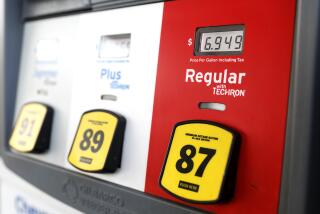Behind Chevron’s feel-good, misleading ad campaign
It’s easy to get cheesed about high gas prices when oil companies are raking in billions of dollars in profit. Chevron, for one, wants you to know that it’s thinking the same.
“Oil companies should put their profits to good use,” the company declares in recent newspaper ads. And in response to that laudable sentiment, Chevron’s chief financial officer, Patricia Yarrington, says, “We agree.”
The ads go on to say that “California’s economy needs energy to grow. And we’re providing it. Reinvesting over $7 billion into the state over the past 5 years. Bringing new energy to market, helping support thousands of jobs, and boosting small businesses. We’re making every penny count.”
Considering that Chevron has reported $6.2 billion in profit for the first three months of the year, up 36% from a year earlier — and $19 billion for last year, nearly double its 2009 earnings — that’s a bold statement.
Equally bold was the testimony of oil industry leaders Thursday in Congress. They were making the case for why some $4 billion in annual federal subsidies and tax incentives should remain in place despite the companies’ bulging pockets.
“Don’t punish our industry for doing our job well,” said John Watson, Chevron’s chief exec.
OK, then perhaps Chevron can tell us how exactly it’s reinvested $7 billion into California. Was it in building new facilities and creating new jobs? Was it in developing alternative energy sources? Investing in solar companies? Or was it something as mundane as simply paying its taxes?
I’ll get to what Chevron had to say — and why the company isn’t fooling anyone. But first, let’s take a closer look at this ad campaign the company’s running.
The “We Agree” newspaper ads and radio and TV commercials debuted in October. According to the company, they highlight “the common ground Chevron shares with people around the world on key energy issues.”
The campaign was launched just few months after the BP oil spill in the Gulf of Mexico and four months before Chevron was hit with a $9.5-billion judgment in a long-running lawsuit alleging that the company was responsible for poisoning the Ecuadorian rainforest. The oil giant is appealing the judgment.
Chevron’s ad campaign was spoofed in a video by the website Funny or Die: Actors portraying company execs happily sign on to the “We Agree” concept after realizing they can claim credit for being socially aware while committing to nothing.
So in California’s case, what has Chevron actually done to put its profits to good use?
When I spoke this week with Brent Tippen, a Chevron spokesman, he asked how detailed a response I wanted. Very detailed, I told him. Let the people of California know exactly where that $7 billion went.
The next day, Tippen said by email that the $7 billion cited in the “We Agree” ads “represents our combined capital investments in our business between 2005 and 2009.”
“The majority of those investments went to maintaining and expanding our major business assets in California, including oil and natural gas production in the San Joaquin Valley, as well as our manufacturing centers in El Segundo and Richmond,” he said.
“It also includes smaller capital investments in our technology and service businesses in California. These capital investments help sustain our business in California, which produces jobs, tax revenues and economic output.”
Hmm. Not so detailed after all. Tippen declined to elaborate, saying that “specific capital expenditures are proprietary information.”
I went online to see if I could find any additional info about Chevron pumping billions of dollars into its California oil and gas facilities. All I found were plans for a major expansion of the company’s refinery in Richmond, across the bay from San Francisco.
But that project came to a halt in 2009 when the California 1st District Court of Appeal ruled that Chevron had botched its environmental impact report. The project remains in limbo.
Tippen sent me a Chevron-funded report by the Milken Institute showing that the oil company employed almost 10,000 California workers in 2007 (before the recession hit; there have since been layoffs). Those workers, the report said, earned about $1.2 billion and accounted for about $4.5 billion in productivity.
The report also said that when you factor in state income taxes paid by Chevron workers, plus corporate, property and sales taxes, Chevron accounted for just under $2 billion in total taxes paid in 2007.
Moreover, it said, smaller businesses get a boost from all the money spent not just by Chevron workers but also by workers at stores and restaurants patronized by Chevron workers.
In other words, if a Chevron employee leaves a tip at a restaurant, and the restaurant server then spends that tip elsewhere, that’s an example of Chevron reinvesting in California.
Is that what the company seemed to be implying with its “We Agree” ads when it talked about oil companies putting their profits to good use? No.
The clear implication of the ads is that Chevron believes it has a responsibility to spend its massive profits on good works. Examples of this might include hefty investments in green energy and technology, contributions to schools, social programs and other community resources, even support for the arts.
Maintaining and possibly expanding existing facilities, giving your workers a steady paycheck and paying your taxes — these don’t seem to be examples of a company that’s going above and beyond the call of corporate duty.
I don’t knock Chevron for wanting to burnish its image at a time when oil companies are seen as bloated ticks on the American hide. But if you’re going to spend millions of dollars on an ad campaign centered on being a sensitive and socially conscious member of society, you’d better have the goods to back it up.
Can we agree on that much?
David Lazarus’ column runs Tuesdays and Wednesdays. He also can be seen daily on KTLA-TV Channel 5. Send your tips or feedback to david.lazarus@latimes.com.
More to Read
Start your day right
Sign up for Essential California for news, features and recommendations from the L.A. Times and beyond in your inbox six days a week.
You may occasionally receive promotional content from the Los Angeles Times.







